前言:介紹完了二元樹的建立和走訪方式,緊接著要來介紹其他基本應用,一樣用上一篇的程式碼進行修改
可以先把之前的程式碼改成T指針類型,後續的操作會比較方便,更改方式如圖:
注意!!! BiTree()原本T的地方改成root,避免命名重複導致程式錯誤(一開始命名的不好是我的疏忽˃ʍ˂)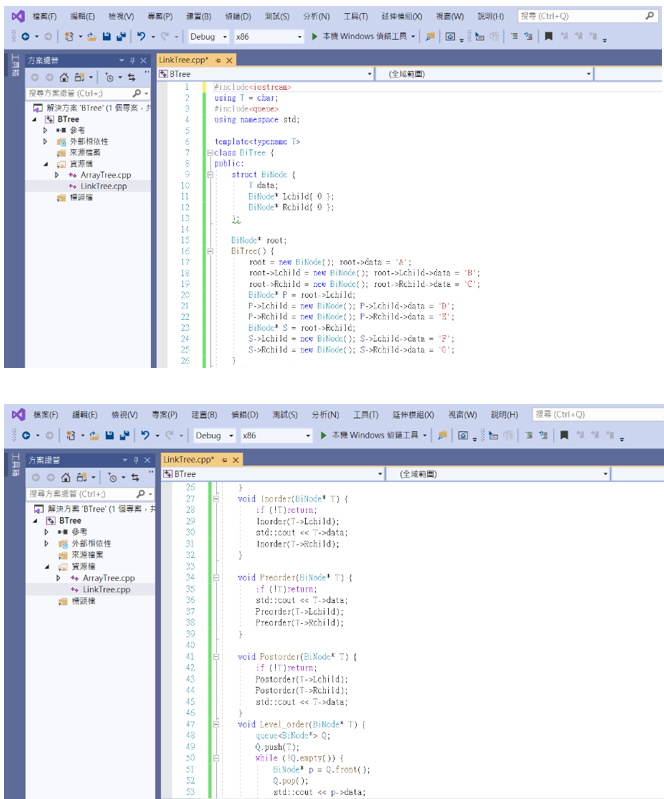
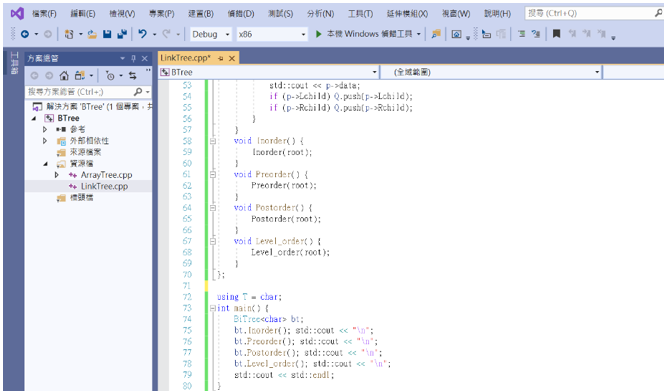
接著就可以開始實作囉
1.求二元樹的深度
可以看到樹的深度如預期的一樣為3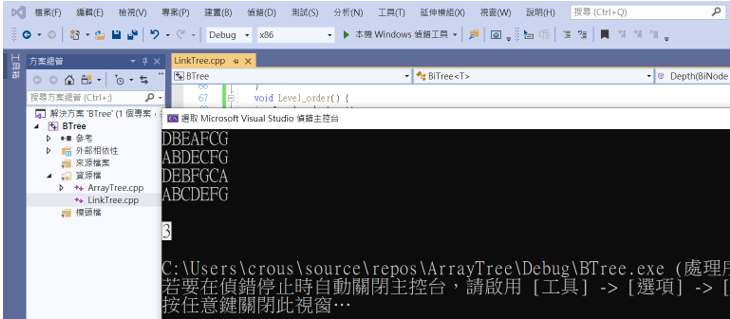
2.計算樹的葉節點數目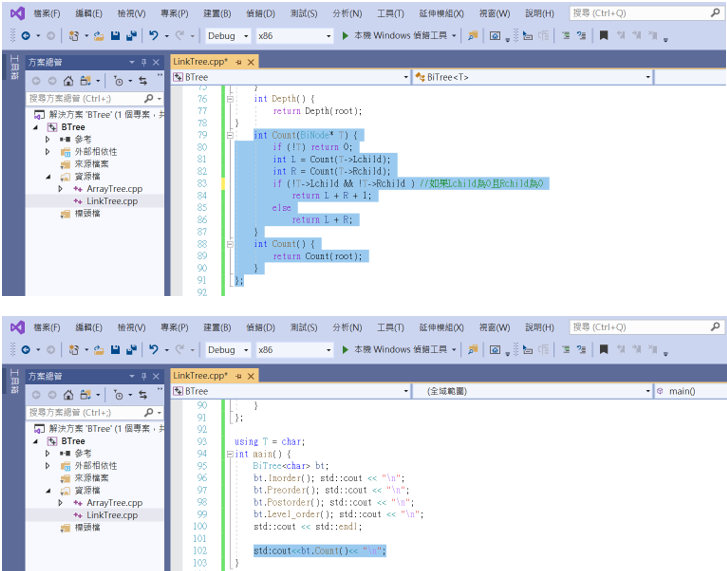
可以看到葉節點的各數為4(DEFG)。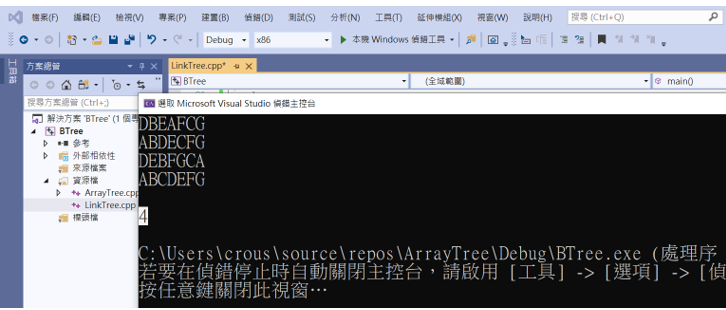
也可以把判斷式改成if (!T->Lchild && !T->Rchild || !T->Lchild && T->Rchild)則可以檢查多餘的節點,來判斷是否為嚴格二元樹。
3.利用空節點標記符號(#)來建立二元樹
相信很多人不懂這題的意思,其實是在走訪節點的下一個節點不存在時(沒有子節點),輸出一個#。
先修改之前的前序走訪作為範例。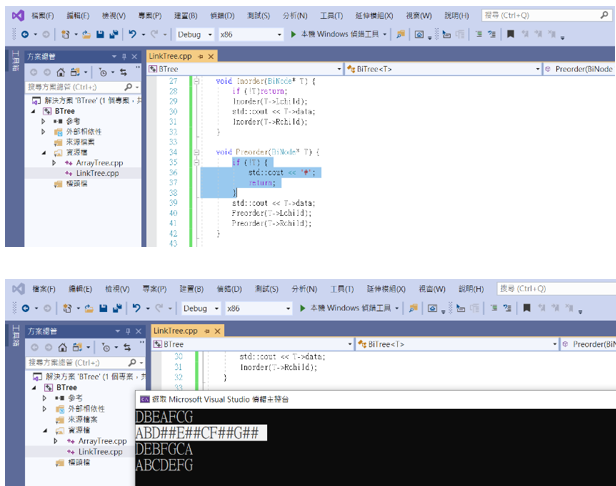
這樣做的意義在哪呢?
這樣做是方便還原二元樹的樣貌,如果沒有這些符號,二元樹會有多種可能,不只是人,連電腦也無法判斷出這個二元樹原本的樣貌,來實際畫畫看就知道了。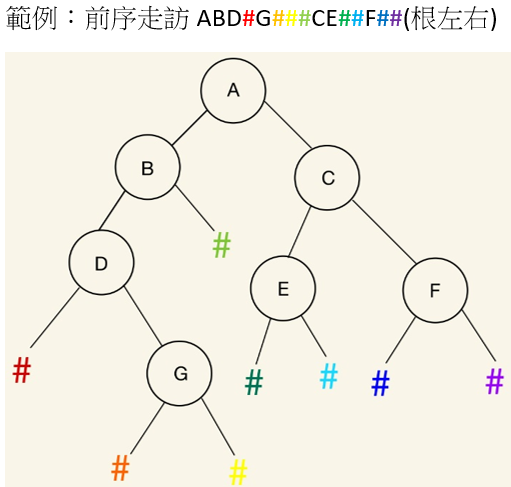
左節點優先權大於右節點,所以都是先從左邊開始畫
接著我們現在要做的就是輸入一串帶有空節點符號的前序序列,來讓電腦建立二元樹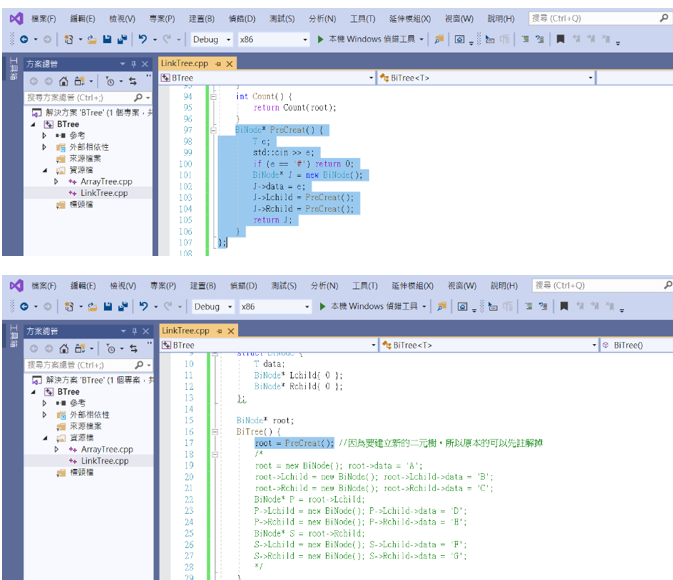
接著輸入前序串列
如果有跑出結果就代表建立成功,順便檢查和第三行是不是一樣
這種方法也可以用在另外三種走訪方式,有興趣的人可以自己操作看看
今日小結:今天講了一些常見但實用的小技巧,尤其是第三個利用空節點符號轉回二元樹的方法,算是相當重要的必備技能,其實樹還有非常多衍生跟應用,只不過也是會花太多篇幅,有機會再向大家介紹,樹的部分先告一段落,明天也將要進入新的環節。
#include<iostream>
using T = char;
#include<queue>
using namespace std;
template<typename T>
class BiTree {
public:
struct BiNode {
T data;
BiNode* Lchild{ 0 };
BiNode* Rchild{ 0 };
};
BiNode* root;
BiTree() {
root = PreCreat(); //因為要建立新的二元樹,所以原本的可以先註解掉
/*
root = new BiNode(); root->data = 'A';
root->Lchild = new BiNode(); root->Lchild->data = 'B';
root->Rchild = new BiNode(); root->Rchild->data = 'C';
BiNode* P = root->Lchild;
P->Lchild = new BiNode(); P->Lchild->data = 'D';
P->Rchild = new BiNode(); P->Rchild->data = 'E';
BiNode* S = root->Rchild;
S->Lchild = new BiNode(); S->Lchild->data = 'F';
S->Rchild = new BiNode(); S->Rchild->data = 'G';
*/
}
void Inorder(BiNode* T) {
if (!T)return;
Inorder(T->Lchild);
std::cout << T->data << " ";
Inorder(T->Rchild);
}
void Preorder(BiNode* T) {
if (!T) {
std::cout << "#" << " ";
return;
}
std::cout << T->data;
Preorder(T->Lchild);
Preorder(T->Rchild);
}
void Postorder(BiNode* T) {
if (!T)return;
Postorder(T->Lchild);
Postorder(T->Rchild);
std::cout << T->data << " ";
}
void Level_order(BiNode* T) {
queue<BiNode*> Q;
Q.push(T);
while (!Q.empty()) {
BiNode* p = Q.front();
Q.pop();
std::cout << p->data << " ";
if (p->Lchild) Q.push(p->Lchild);
if (p->Rchild) Q.push(p->Rchild);
}
}
void Inorder() {
Inorder(root);
}
void Preorder() {
Preorder(root);
}
void Postorder() {
Postorder(root);
}
void Level_order() {
Level_order(root);
}
int Depth(BiNode* T){
if (!T) return 0;
int L = Depth(T->Lchild);
int R = Depth(T->Rchild);
return L > R ? L + 1 : R + 1; //如果L>R,那麼樹深將會是L的深度+1,否則是R的深度+1
}
int Depth() {
return Depth(root);
}
int Count(BiNode* T) {
if (!T) return 0;
int L = Count(T->Lchild);
int R = Count(T->Rchild);
if (!T->Lchild && !T->Rchild) //如果Lchild不為0且Rchild不為0
return L + R + 1;
else
return L + R;
}
int Count() {
return Count(root);
}
BiNode* PreCreat() {
T e;
std::cin >> e;
if (e == '#') return 0;
BiNode* J = new BiNode();
J->data = e;
J->Lchild = PreCreat();
J->Rchild = PreCreat();
return J;
}
};
using T = char;
int main() {
BiTree<char> bt;
bt.Inorder(); std::cout << "\n";
bt.Preorder(); std::cout << "\n";
bt.Postorder(); std::cout << "\n";
bt.Level_order(); std::cout << "\n";
std::cout << std::endl;
std:cout<<bt.Count()<< "\n";
}
